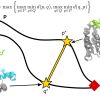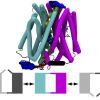
AdK apo PMF
The enzyme adenylate kinase (AdK) undergoes a large hinge-like motion. In 2009, we studied the conformational transition between open and closed E. coli AdK without substrate, i.e. “apo AdK”, with a variety of computational methods. As part of the study we also produced a free energy landscape (a potential of mean force or PMF) as a function of the two domain angles. Here we make the data of the underlying free energy landscape available to other researchers so that they can use them in their own research.



